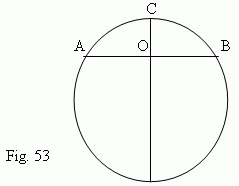Geometrical locus. Circle and circumference
Circumference. Circle. Arc. Secant. Chord. Diameter. Tangent line.
Segment of a circle. Sector of a circle. Angles in a circle.
Central angle. Inscribed angle. Circumscribed angle.
Radian measure of angles. Round angle. Ratio of
circumference length and diameter. Length of an arc.
Huygens' formula. Relations between elements of a circle.
Geometrical locus ( or simply locus ) is a totality of all points, satisfying the certain given conditions.
E x a m p l e 1. A midperpendicular of any segment is a locus, i.e. a totality of all points,
equally
removed from the bounds of the segment. Suppose that PO
![]() AB and
AO = OB :
AB and
AO = OB :
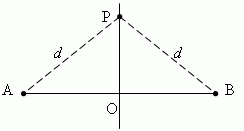
Then, distances from any point P, lying on the midperpendicular PO, to bounds A and B of the segment AB are both equal to d . So, each point of a midperpendicular has the following property: it is removed from the bounds of the segment at equal distances.
E x a m p l e 2. An
angle bisector is a locus , that is a totality of all points, equally removed from the angle sides.
E x a m p l e 3. A circumference is a locus, that is a totality of all points ( one of them - A ),
equally removed from its center O.
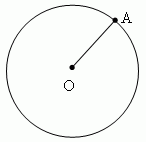
Circumference is a geometrical locus in a plane, that is a totality of all points, equally removed from its center. Each of the equal segments, joining the center with any point of a circumference is called a radius and signed as r or R . A part of a plane inside of a circumference, is called a circle . A part of a circumference ( for instance, A m B, Fig.39 ) is called an arc of a circle. The straight line PQ, going through two points M and N of a circumference, is called a secant ( or transversal ). Its segment MN, lying inside of the circumference, is called a chord.
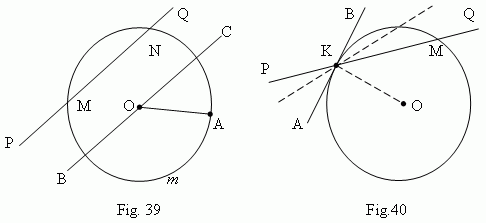
A chord, going through a center of a circle ( for instance, BC, Fig.39 ), is called a diameter and signed as d or D . A diameter is the greatest chord of a circle and equal to two radii ( d = 2 r ).
Tangent. Assume, that the secant PQ ( Fig.40 ) is going through points K and M of a circumference. Assume also, that point M is moving along the circumference, approaching the point K. Then the secant PQ will change its position, rotating around the point K. As approaching the point M to the point K, the secant PQ tends to some limit position AB. The straight line AB is called a tangent line or simply a tangent to the circumference in the point K. The point K is called a point of tangency. A tangent line and a circumference have only one common point – a point of tangency.
Properties of tangent.
1)
A tangent to a circumference is perpendicular to a radius, drawing to a point of
tangency
( AB
![]() OK, Fig.40 )
.
OK, Fig.40 )
.
2)
From a point, lying outside a circle, it can be drawn two tangents to the same
circumference; their segments lengths are equal
( Fig.41 ).
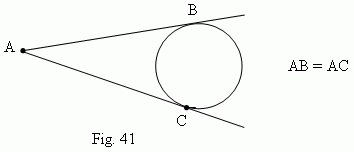
Segment of a circle is a part of a circle, bounded by the arc ACB and the corresponding chord AB ( Fig.42 ). A length of the perpendicular CD, drawn from a midpoint of the chord AB until intersecting with the arc ACB, is called a height of a circle segment. Sector of a circle is a part of a circle, bounded by the arc A m B and two radii OA and OB, drawn to the ends of the arc ( Fig.43 ).
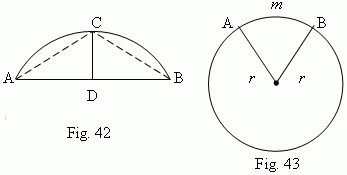
Angles in a circle.
A
central angle
–
an angle, formed by two radii of the circle (
![]() AOB,
Fig.43 ). An
inscribed angle
– an angle, formed by two chords AB and AC, drawn from one common point (
AOB,
Fig.43 ). An
inscribed angle
– an angle, formed by two chords AB and AC, drawn from one common point (
![]() BAC,
Fig.44 ).
BAC,
Fig.44 ).
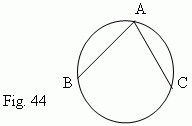
A
circumscribed angle
– an angle, formed by two tangents AB and AC, drawn from one common point (
![]() BAC,
Fig.41 ).
BAC,
Fig.41 ).
A length of arc
of a circle is proportional to its radius
r
and the corresponding central angle
![]() :
:
So, if we know an arc length
l
and a radius
r
, then the value of the corresponding central angle
![]() can
be determined as their ratio:
can
be determined as their ratio:
This formula is a base for definition of a
radian measure
of angles. So, if
l
=
r,
then
![]() = 1, and we say, that an angle
= 1, and we say, that an angle
![]() is equal to 1 radian (
it is designed as
is equal to 1 radian (
it is designed as
![]() = 1
rad
). Thus, we have the following definition of a radian
measure unit:
A radian is a central angle
(
= 1
rad
). Thus, we have the following definition of a radian
measure unit:
A radian is a central angle
(
![]() AOB, Fig.43 ),
whose arc’s length is equal to
its radius
( AmB = AO, Fig.43 ). So,
a radian measure of any angle is a ratio of a length of an arc, drawn by an arbitrary radius and concluded
between the sides of this angle, to the radius of the arc.
Particularly, according to the formula for a length of an arc, a length of a circumference
C
can be expressed as:
AOB, Fig.43 ),
whose arc’s length is equal to
its radius
( AmB = AO, Fig.43 ). So,
a radian measure of any angle is a ratio of a length of an arc, drawn by an arbitrary radius and concluded
between the sides of this angle, to the radius of the arc.
Particularly, according to the formula for a length of an arc, a length of a circumference
C
can be expressed as:
where
![]() is determined as ratio of
C
and a diameter of a circle 2
r
:
is determined as ratio of
C
and a diameter of a circle 2
r
:
![]() is an irrational number; its approximate value is 3.1415926…
is an irrational number; its approximate value is 3.1415926…
On the other hand, 2
![]() is a
round angle
of a circumference, which in a degree
measure is equal to 360 deg. In practice it often occurs, that both radius and angle of a circle are unknown. In this case, an arc length can be
calculated by the approximate Huygens’ formula:
is a
round angle
of a circumference, which in a degree
measure is equal to 360 deg. In practice it often occurs, that both radius and angle of a circle are unknown. In this case, an arc length can be
calculated by the approximate Huygens’ formula:
where ( according to Fig.42 ):
p
– a length of the arc ACB;
l
– a length of the chord AC;
L
– a
length of the chord AB. If an arc contains not more than 60 deg, a relative error of this formula is less than 0.5%.
Relations between elements of a circle. An inscribed angle (
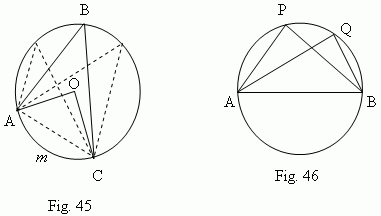
All inscribed angles, based on a semi-circle
(
![]() APB,
APB,
![]() AQB, …,
Fig.46 ),
are right angles
( Prove this, please ! ).
An angle
(
AQB, …,
Fig.46 ),
are right angles
( Prove this, please ! ).
An angle
(
![]() AOD,
Fig.47 ),
formed by two chords
( AB and CD ),
is measured by a semi-sum of arcs, concluded between its sides:
AOD,
Fig.47 ),
formed by two chords
( AB and CD ),
is measured by a semi-sum of arcs, concluded between its sides:
( A
n
D + C
m
B ) / 2 .
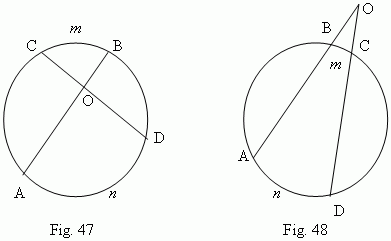
An angle
(
![]() AOD, Fig.48 )
, formed by two secants
( AO and OD ),
is measured
by a semi-difference of arcs, concluded between its sides:
( A
n
D – B
m
C
) / 2 .
An angle
(
AOD, Fig.48 )
, formed by two secants
( AO and OD ),
is measured
by a semi-difference of arcs, concluded between its sides:
( A
n
D – B
m
C
) / 2 .
An angle
(
![]() DCB, Fig.49 )
, formed by a tangent and a chord
( AB and CD ),
is measured by a half of an arc, concluded inside of it:
C
m
D / 2 .
An angle
(
DCB, Fig.49 )
, formed by a tangent and a chord
( AB and CD ),
is measured by a half of an arc, concluded inside of it:
C
m
D / 2 .
An angle
(
![]() BOC, Fig.50 )
,
formed by a tangent and a secant
( CO and BO ),
is measured by a semi-difference of arcs, concluded between its sides:
( B
m
C
–
C
n
D
) / 2 .
BOC, Fig.50 )
,
formed by a tangent and a secant
( CO and BO ),
is measured by a semi-difference of arcs, concluded between its sides:
( B
m
C
–
C
n
D
) / 2 .
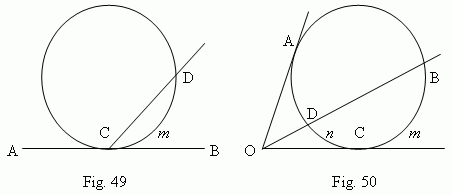
A circumscribed angle
(
![]() AOC, Fig.50 )
, formed by the two tangents,
(CO and AO),
is measured by a semi-difference of arcs, concluded between its sides:
( ABC
–
CDA ) / 2
.
Products of segments of chords
( AB and CD, Fig.51 or Fig.52 ),
into which
they are divided by an intersection point, are equal:
AO · BO = CO · DO.
AOC, Fig.50 )
, formed by the two tangents,
(CO and AO),
is measured by a semi-difference of arcs, concluded between its sides:
( ABC
–
CDA ) / 2
.
Products of segments of chords
( AB and CD, Fig.51 or Fig.52 ),
into which
they are divided by an intersection point, are equal:
AO · BO = CO · DO.
A
square of tangent line segment is equal to a product of a secant line segment by the secant line external part ( Fig.50 ) : OA 2 = OB · OD ( prove, please! ). This property may be considered as a particular case of Fig.52.
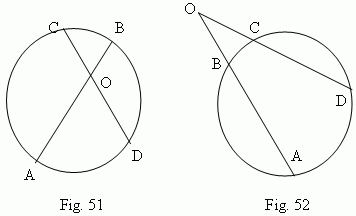
A chord
( AB, Fig.53 )
, which is perpendicular to a diameter
( CD )
, is divided into two in the intersection point
O :
AO = OB
.
( Try to prove this ! ).
